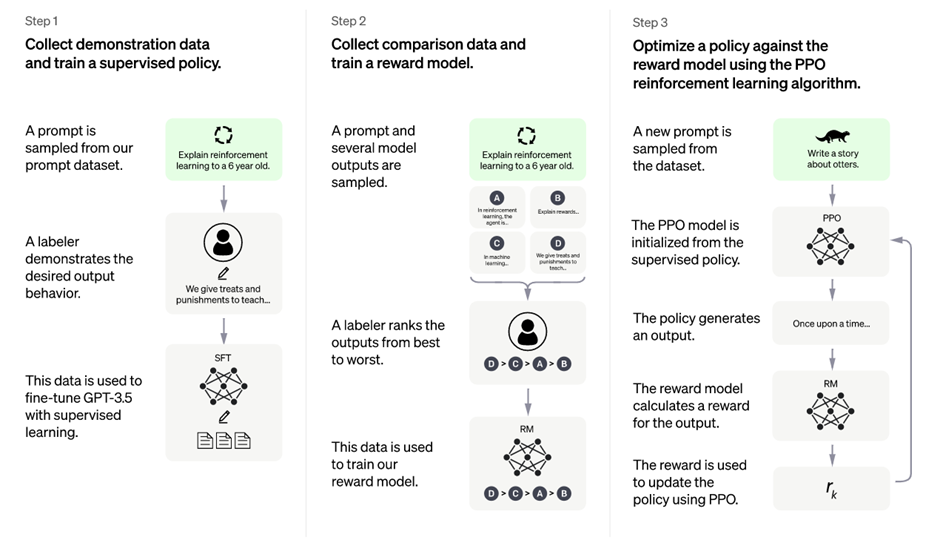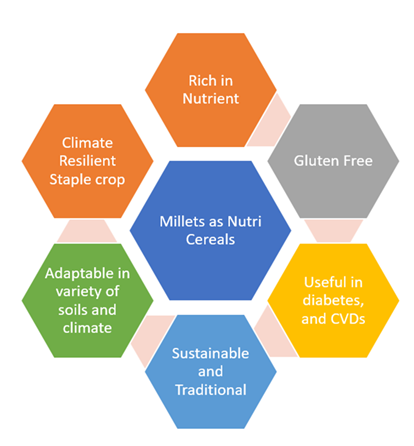Wednesday, 8th February 2023
From Dole to Development: Rural Infrastructure Subsidies
Exam View: Agri-Focused Accelerator Fund, Jal Jeevan Mission, Pradhan Mantri Kaushal Vikas Yojana 4.0, Gati Shakti, and PM Awas Yojana (Gramin).
In News:
The recent announcement of the Agri-Focused Accelerator Fund by the finance minister and also talked about creating digital public infrastructure for agriculture as an open-source, open-standard, and interoperable public good.
The finance minister announced a bold step to reorient support in the agri-food-rural space from doles towards development. She resisted the temptation to announce freebies. Instead, she has proposed a growth-oriented, asset-creating, and inclusive budget to develop better infrastructure and create more productive jobs.
There is a drastic cut in food and fertilizer subsidies and also reduced expenditure on MGNREGA in 2023-24 compared to the revised estimates (RE) of 2022-23. But this does not mean that there will be a decrease in agriculture and rural spending because the savings from these doles have been redirected towards more productive expenditures on railways, roads, rural housing, and Jal Shakti — this will help rural India through its multiplier effects.
- Focus on Agriculture: Agri-Focused Accelerator Fund and digital public infrastructure for agriculture as an open-source, open-standard, and interoperable public good. This will enable inclusive and farmer-centric solutions by providing information services for crop planning and health and improving access to farm inputs, credit, and insurance. Farmers will be able to arrive at better crop estimates and get market intelligence.
- A positive step towards promoting high-value horticultural crops was announced under the Atmanirbhar Clean Plant Programme which aims to boost the availability of disease-free, quality planting material.
- Focus on Jal Jeevan Mission: An increase of 27.3 percent is also seen in the Jal Jeevan Mission (JJM), from Rs 55,000 crore in RE of 2022-23 to Rs 70,000 crore for 2023-24.
- This is primarily to supply safe drinking water through taps, mostly in rural areas. This will not only help contain waterborne diseases but also save time and energy for women who have to walk long distances to fetch water.
- Focus on Skill Development - Pradhan Mantri Kaushal Vikas Yojana 4.0: The outlay for the purpose has gone up by 85 percent — from Rs 1,902 crore (RE) in 2022-23 to Rs 3,517 crore (BE) in 2023-24.
- It aims to empower the “Amrit Peedhi” and provide skills to lakhs of youth within the next three years. It envisages on-job training, forging partnerships with the industry, and aligning courses with the needs of the industry. The Pradhan Mantri Kaushal Vikas Yojana also targets to cover new age courses for an industry like coding, AI, robotics, mechatronics, and 3D printing.
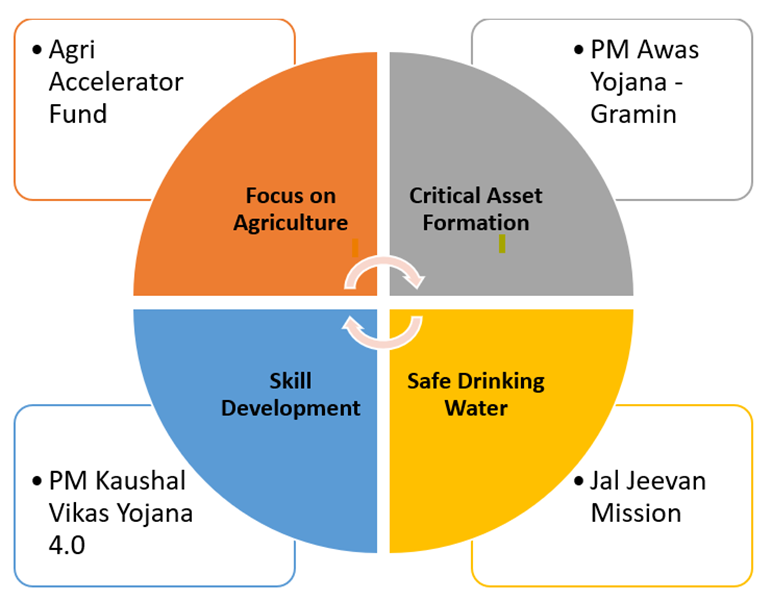
- Focus on Gati Shakti to reduce the cost of logistics: Railway outlay is up 48.6 percent at Rs 2.41 lakh crore in 2023-24, from the revised estimate of Rs 1.62 lakh crore in 2022-23. Road transport and highways have a capital outlay of Rs 2.70 lakh crore in 2023-24 against Rs 2.17 lakh crore in 2022-23 (RE).
- Logistics and supply chain costs account for around 12 percent of the GDP in India compared to the global average of 8 percent. Improving connectivity through rail, road, air, and waterways will surely improve the competitiveness of Indian products, including that of agricultural produce in global markets, and also help in taming inflation.
- PM Awas Yojana (Gramin) – Focus on Critical asset creation: The overall outlay for PM Awas Yojana has increased to Rs 54,487 crore, up from Rs 20,000 crore that was budgeted in the 2022-23 budget — a net increase of 172.4 percent.
- The scheme was launched in 2016 to provide housing to all but it also ensures permanent asset creation for rural households and provides the dignity of life while creating more jobs in rural India. This marks a big step forward in reorienting subsidies towards rural infrastructure development.
The creation of storage facilities and value chain infrastructure remains a challenge in rural areas. There is a need to double up investment in agriculture research for creating more productive, climate-resilient, and competitive agriculture in India.
https://indianexpress.com/article/opinion/columns/from-doles-to-development-budget-has-done-well-to-reorient-government-spending-on-subsidies-towards-rural-infrastructure-schemes-8425935/
Fiscal Policy of The Government
In News:
As per the Union Budget 2023-24, Indian economy is projected to witness a decline in fiscal deficit to 5.9% of GDP in FY24, compared with 6.4% in FY23 due to fiscal consolidation measures by the government
About the News:
- The Union Budget 2023-24 provides this fiscal deficit road map:
|
|
FY24 |
2022-23 (Revised Estimate) |
|
Fiscal Deficit |
5.9% |
6.4% |
|
Revenue Deficit |
2.9% |
4.1% |
|
Primary Deficit |
2.3% |
3% |
- Rationalisation of food, fertiliser and petroleum subsidies to meet fiscal deficit target:
|
|
2023-24 |
2022-23 (Revised Estimate) |
|
Food |
₹1,97,350 crore |
₹2,87,194 crore |
|
Fertiliser |
₹1,75,100 crore |
₹2,25,220 crore |
|
Petroleum |
₹2,257 crore |
₹9,171 crore |
- In Union Budget 2023, India’s external debt is pegged at ₹22,118 crore of the total fiscal deficit of ₹17,86,816 crore in 2023-24 (BE), which is approximately about 1%.
- In Union Budget 2023, it is also stated that the States will have to maintain a fiscal deficit of 3.5% of GSDP of which 0.5% will be tied to power sector reforms.
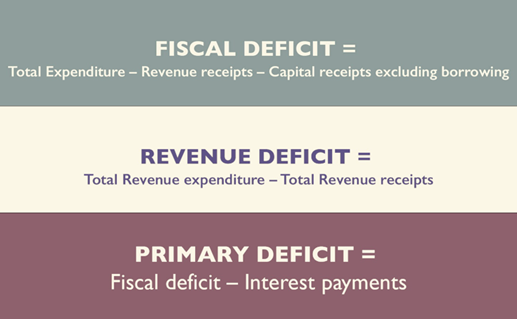

What are the steps being taken by the government to reach its fiscal policy target?
- Accommodative fiscal policy formulation:
- Fiscal policy needs to remain “accommodative” with focus on gross capital formation in the economy with enhanced capital spending.
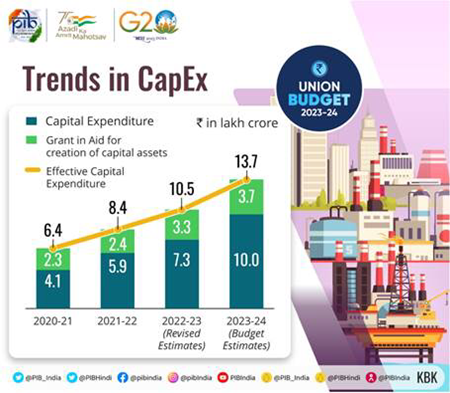
- Capital expenditure to support economic growth recovery:
- In Budget 23-24, capital spending is expected to rise to 3.3% of GDP.
- The interest-free loan of ₹1.3 lakh crore for 50 years provided to States should help them spend and boost growth.
- Financing fiscal deficit through internal market borrowings:
- It is also to be financed through securities against small savings, provident funds and an insignificant component of external debt.
- Inflation control:
- Interest rate management is being done by the RBI through its monetary policy.
- RBI has been increasing policy rates to tackle mounting inflation.
- But a high interest rate regime can hurt the economic growth process.
- Also it is not a sufficient step to effectively control inflation due to the supply side shocks. An accommodative fiscal policy will help buffer this shock.
- Infrastructure investment:
- Leveraging buoyant revenue, the Government plans to substantially increase spending on infrastructure.
- It has a larger multiplier effect on economic growth and employment.
- It will boost private investment.
- Capital support for the oil sector.
- The Budget plans are credit positive for renewable energy companies, cement and steel producers, oil marketing companies and automakers.
Source:
https://www.thehindu.com/business/budget/explained-is-the-government-on-track-on-fiscal-deficit-targets/article66472080.ece#:~:text=The%20Government%20has%20not%20deviated,26%20from%20the%20current%206.4%25.
Muography In Archaeo-Geophysics
In News:
Researchers examine the fortress wall of Ancient city of Xi’an in China, by using tiny outer space particles known as muons that can penetrate hundreds of metres of stone surfaces.
About the News:
Muon tomography or muography using advanced muon detector CORMIS (Cosmic Ray Muon Imaging System) is being applied in archaeo-geophysics to study the Xi’an defensive walls and generate three-dimensional images of such large structures. This approach can change the study of archaeology.
- It can help in identifying endangered cultural relics and monuments.
- It can help in the restoration of such relics.

What are muons?
- Muons are subatomic particles like photons or gluons.
- Origin: They are created when the particles in Earth’s atmosphere collide with cosmic rays.
- The collision creates a cluster of high energy particles that move through space at just below the speed of light.
- About 10,000 muons reach every square metre of the Earth’s surface a minute.
- Fat electrons: These particles resemble electrons but are 207 times as massive hence referred to as “fat electrons”
- Because of their heaviness, they can travel through hundreds of metres of rock or other matter before getting absorbed or decaying into electrons and neutrinos. Electrons can penetrate through a few centimetres.
- Stability: They are highly unstable and exist for just 2.2 microseconds.

What is muon tomography or muography?
Muography is a scanning technique conceptually similar to X-ray but capable of scanning much larger and wider structures, owing to the penetration power of muons.
- Technique: The high-energy particles are naturally produced and are ubiquitous hence, to scan an object, muon detector is placed underneath, within or near the object of interest.
- The detector then tracks the number of muons going through the object from different directions, to form a three-dimensional image.
- The image is then compared with a muon image of the “free sky.” This indicates how many muons have been blocked.
- The final picture is essentially a shadow of the object, in the light of cosmic muons.”
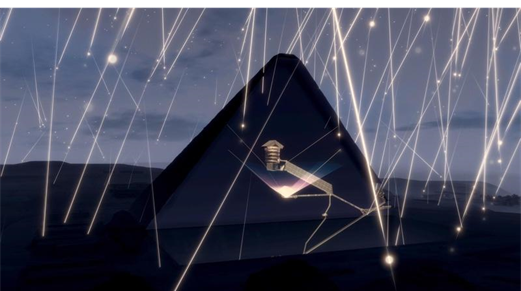
- Egypt research: The technique was first used in the late 1960s, when Nobel Laureate and US experimental physicist Luis Alvarez joined hands with Egyptologists to search for hidden chambers in the Pyramid of Khafre, Giza. Nothing was found
- Researchers in 2017 used more sophisticated and advanced muon detectors and were able to find an unknown chamber.
- Other applications:
- Customs security
- Borehole muography: Imagine subsurface rock formations or geological objects like oil and gas reservoirs, mineral deposits, cavities etc.
- Industries: Preventive maintenance of equipments, defect check in products like cars, machines etc
- Internal imaging of volcanoes: Mount Vesuvius is being analysed using this technique to predict what hazards to expect in an eventual eruption.
- Fukushima nuclear reactor accident (2011): scientists who went to look inside the reactor in 2015, put two muon detectors in 10 centimetres thick boxes to protect themselves from radiation.

Source:
https://indianexpress.com/article/explained/explained-sci-tech/scientists-outer-space-particles-xian-city-fortress-muons-8423710/
Legal Aid Defense Counsel System (LADCS)
In News:
- Recently, Chief Justice of Telangana High Court inaugurated Legal Aid Defense Counsel System (LADCS)
About the News:
- LADCS will come at rescue to majority of the under-trial prisoners belong to marginalised and weaker sections.
- The new offices of the LADCS will be in 16 districts of the State and would help facilitating trails for needy and distressed persons in the State.
- At present, legal aid is being offered in criminal matters to the accused or convicts coming under the Legal Services Act-1987.
- The new systems involve full-time engagement of lawyers with suitable support systems to deal exclusively with legal aid work in criminal matters in the district headquarters.
- Article 39A of the Constitution provides for free Legal aid to the people who are unable to afford legal representation and access to the court system especially due to financial condition.
About LADCS:
- The Legal Aid Defense Counsel System (LADCS) is a legal aid system in India established to provide access to justice to the marginalized and weaker sections of society who cannot afford legal representation.
- It offers legal aid at various stages of a criminal case, including pre-arrest, remand, trial, and appellate stages.
- The system operates through a network of offices located in different districts across the state, where full-time lawyers are engaged to deal exclusively with legal aid work in criminal matters.
- The LADCS are governed by the Legal Services Act-1987, which mandates the provision of legal aid to eligible accused or convicted persons.
- The system is headed by Chief Legal Aid Defense Counsels, with support from Deputy LADCs and Assistant LADCs.
- The LADCS is an important step in ensuring that every person has access to justice, regardless of their financial situation.
- By providing legal representation and support, the LADCS helps to ensure that the rights of marginalized and weaker sections are protected and that they have a fair chance of securing a just outcome in their cases.
- Eligibility for Free legal aid: As per the Indian legal system, the marginalized and weaker sections eligible for free legal aid include:
- Dalits or Scheduled Castes, Tribals or Scheduled Tribes, Women, Children, Senior Citizens, Persons with disabilities and Indigent persons.
Important schemes for free legal services:
- Legal Services Authorities Act, 1987: This act provides for the establishment of legal services authorities at the national and state levels, which offer free legal services to eligible persons and groups.
- National Legal Services Authority (NALSA): NALSA is the national level legal services authority established under the Legal Services Authorities Act, 1987. It provides free legal services to eligible persons and groups, including Dalits, tribals, women, children, and senior citizens.
- State Legal Services Authorities (SLSAs): These are state-level legal services authorities established under the Legal Services Authorities Act, 1987 to offer free legal services to eligible persons and groups within the state.
- Legal Aid Clinics: These are established in various parts of the country to provide free legal services to marginalized sections of society and are usually run by law schools, NGOs, and other organizations working in the field of legal aid.
- Legal Literacy Campaigns: These are organized by various legal services authorities and NGOs to create awareness about the legal rights of marginalized sections and to provide them with access to justice.
- District Legal Services Authorities (DLSAs): These are district-level legal services authorities established under the Legal Services Authorities Act, 1987 to provide free legal services to eligible persons and groups within the district.
- Para-Legal Volunteer (PLV) Scheme: It is a scheme aimed at providing free legal services to eligible persons and groups through a network of para-legal volunteers trained in basic legal services.
https://www.thehindu.com/news/national/telangana/cj-inaugurates-new-legal-aid-defense-counsel-system/article66478941.ece/amp/
Hate Crime - Edukemy Current Affairs
In news
- The Supreme Court stated that there was no room for hate crimes in a secular country like India very recently.
About
- Hate crimes are cruel expressions of narrow-mindedness and have a significant negative impact on the victim as well as the group they identify with. They have an impact on social stability and group cohesiveness.
- The basis of hate crimes includes religion, caste, ethnicity, and sexual orientation.
- The consequences of it could be acts of violence, threats or intimidation against an individual or a community.
- It is a constitutional obligation to see that every person irrespective of religion, creed, caste can walk freely at any point of time. This is the primary duty of the state to protect every citizen against it.
|
Constitutional values and Legal Provision |
|
Constitutional Values
Legal Provisions against Hate Crimes
|
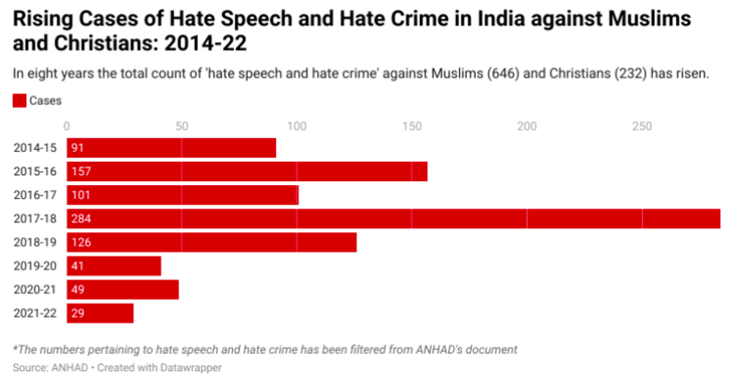
https://indianexpress.com/article/india/no-scope-for-hate-crimes-on-basis-of-religion-in-secular-country-such-as-india-sc-8427939/
Visva-Bharati to be World’s First Living Heritage University
In news
- For the first time Visva-Bharati University, a functioning university shall be given heritage tag from UNESCO.
About
- It is located in Shantiniketan, West Bengal.
- It was founded by Rabindranath Tagore, a nobel laureate in .
- Rabindranath Tagore strongly believed that open-air education should be imparted and this practice is followed even today.
- Visva-Bharati was inaugurated as a Centre for Culture with exploration into the arts, language, humanities, music and these are reflected in diverse institutes that continue in their educational programmes like including Hindi studies, Sino-Asian studies, humanities, fine arts, and music.
- Until Independence, it was a college and the institution was given the status of Central University in 1951 through a Central Act.
Architectural style
- Kalo Bari: A mud structure with coal tar finish and sculpture panels
- Mastermoshai studio: a single story structure built for the first principal of Kala Bhavan, Nandalal Bose
- Murals and paintings on Cheena and Hindi Bhavan

https://indianexpress.com/article/cities/kolkata/unesco-to-soon-declare-visva-bharati-worlds-first-living-heritage-university-8424445/
30th Anniversary of The Indo-Russian Friendship Treaty Of 1993
In news
- Year 2023 marks the 30th anniversary of Indo-Russian Friendship Treaty 1993.

About
- After the dissolution of USSR in 1991, Treaty of Friendship and Cooperation replaced Treaty of Peace, Friendship and Cooperation (1971) between India and Russia.
Political ties
- Since the signing of “Declaration on the India-Russia Strategic Partnership” in October b, India-Russia ties have acquired a qualitatively new character with enhanced levels of cooperation in almost all areas.
- 2+2 Ministerial Dialogue (Foreign and Defence) is another level of engagement.
Defence
- India-Russia military technical cooperation has evolved from a buyer-seller framework to one involving joint research, development and production of advanced defence technologies and systems.
- BrahMos was jointly produced
- Technology transfer and supply of defence equipment (S-400).
Multilateral and International cooperation
- Russia always supports India’s bid for a permanent seat in UNSC.
- Both the nations are collectively involved in connectivity projects for various regional organisations such as BRICS, SCO, INSTC (International North-South Transport Corridor)
- For India to be a strong regional leader, Russian support is necessary.
Energy security
- Russian oil reserves and supply is inevitably essential for meeting the energy demands of India.
Nuclear Energy
- Russia is an important partner for India in the area of peaceful use of nuclear energy.
https://www.hindustantimes.com/india-news/russian-envoy-questions-us-reliability-as-india-s-defence-and-strategic-partner-101675696659070.html
Southern India’s First Industrial Corridor Project
Why in news? Recently, the Prime Minister of India laid the foundation stone of South India’s 1st Industrial Corridor Project to be implemented at Tumakuru under the Chennai-Bengaluru Industrial Corridor.

About:
- The Tumakuru Industrial Township has been planned in line with the principles of PM-GatiShakti to ensure last-mile multimodal connectivity to the economic zone.
- The Govt of India (via NICD and Implementation Trust) and the Govt of Karnataka are developing the Industrial Township at Vasanthanarasapura in 3 phases in the Tumakuru district through the project Special Purpose Vehicle (SPV).
- Under the National Industrial Corridor Development (NICD) Programme, 32 greenfields industrial smart cities under 11 industrial corridors are being developed with world class Plug-n-Play infrastructure.
https://pib.gov.in/PressReleasePage.aspx?PRID=1896780
Agriculture Extension System - Edukemy Current Affairs
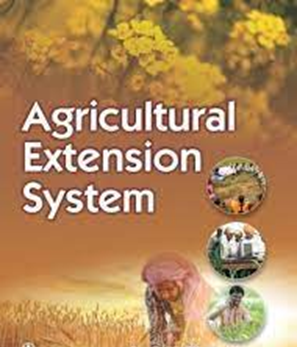
Why in news? Ministry of Agriculture & Farmers Welfare signed a MoU with Digital Green enterprise to build a national level digital extension platform.
About:
- Platform will host a digital library of curated multi-format multi-lingual content and will help deliver curated content to farmers on time.
- Agriculture extension system bridges the gap between research labs to a farmer’s field.
- It offers advice and information to help them solve their problems, increase the efficiency of the family farm, increase production
https://www.livemint.com/industry/agriculture/agriculture-ministry-signs-mou-to-develop-national-level-digital-extension-platform-11675688197728.html
Voice deep fakes - Edukemy Current Affairs
Why in news? A social media platform used speech synthesis to make deep fakes of celebrities.
About:
- A voice deepfake is one that closely mimics a real person’s voice.
- The voice can accurately replicate tonality, accents, cadence, and other unique characteristics of the target person.
- People use AI and robust computing power to generate such voice clones or synthetic voices.
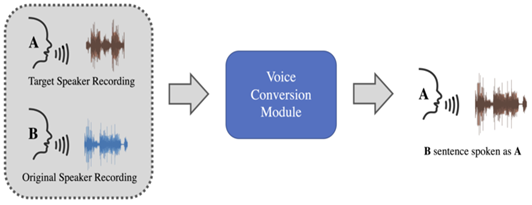
- Threats:
- It can be used to defraud users, steal their identity, and to engage in various other illegal activities like phone scams and posting fake videos on social media platforms and defame celebrities.
- Deepfake audios can make racist, abusive, and violent comments.
- Ways to detect: Multi Factor authentication and anti-fraud solutions, Programmes like Deeptrace etc.
https://www.thehindu.com/sci-tech/technology/explained-voice-deepfakes-how-are-they-are-used/article66476423.ece
Yuva Sangam Portal - Edukemy Current Affairs
Why in news? The “Yuva Sangam” registration portal was recently launched at Indira Gandhi National Centre for the Arts (IGNCA), New Delhi.
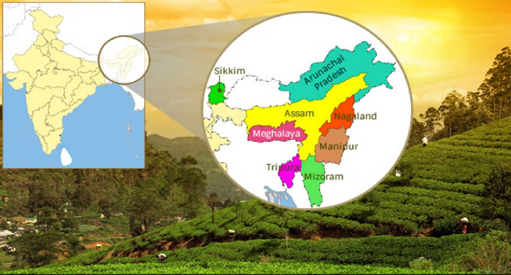
About:
- It is an initiative of the Government of india to strengthen people-to-people connect especially between youth belonging to North-eastern India and other States.
- Under this initiative, over 20000 youth will travel across India and gain a unique opportunity of cross-cultural learning.
- The program is an opportunity for the youth of North-eastern States to see India.
- It is conceptualized under Ek Bharat Shreshtha Bharat (EBSB) in collaboration with various other ministries and departments such as Culture, Tourism, Railways,
https://www.financialexpress.com/education-2/yuva-sangam-portal-launched-to-connect-youth-from-northeast-to-other-states/2973588/
Trade and Technology Council - Edukemy Current Affairs
Why in news? Recently, India and the EU announced the establishment of the three Working Groups under the India-EU Trade and Technology Council and their Terms of Reference.
About:

- Trade and Technology Council (TTC) is a strategic coordination mechanism to allow both partners to tackle challenges at the nexus of trade, trusted technology and security; deepening India-EU bilateral relationship in these fields.
- India-EU TTC was launched in April 2022.
- It is the first such mechanism for India and second for EU, after US-EU TTC.
- Strengthening India-EU relationship as strategic partners, three working groups are formed under India-EU TTC on:
- Strategic Technologies, Digital Governance and Digital Connectivity
- Green and Clean Energy Technologies
- Trade, Investment and Resilient Value Chains
https://economictimes.indiatimes.com/news/economy/foreign-trade/india-eu-to-create-3-working-groups-under-trade-technology-council-to-boost-ties/articleshow/97653256.cms
Share the article
Get Latest Updates on Offers, Event dates, and free Mentorship sessions.

Get in touch with our Expert Academic Counsellors 👋
FAQs
UPSC Daily Current Affairs focuses on learning current events on a daily basis. An aspirant needs to study regular and updated information about current events, news, and relevant topics that are important for UPSC aspirants. It covers national and international affairs, government policies, socio-economic issues, science and technology advancements, and more.
UPSC Daily Current Affairs provides aspirants with a concise and comprehensive overview of the latest happenings and developments across various fields. It helps aspirants stay updated with current affairs and provides them with valuable insights and analysis, which are essential for answering questions in the UPSC examinations. It enhances their knowledge, analytical skills, and ability to connect current affairs with the UPSC syllabus.
UPSC Daily Current Affairs covers a wide range of topics, including politics, economics, science and technology, environment, social issues, governance, international relations, and more. It offers news summaries, in-depth analyses, editorials, opinion pieces, and relevant study materials. It also provides practice questions and quizzes to help aspirants test their understanding of current affairs.
Edukemy's UPSC Daily Current Affairs can be accessed through:
- UPSC Daily Current Affairs can be accessed through Current Affairs tab at the top of the Main Page of Edukemy.
- Edukemy Mobile app: The Daily Current Affairs can also be access through Edukemy Mobile App.
- Social media: Follow Edukemy’s official social media accounts or pages that provide UPSC Daily Current Affairs updates, including Facebook, Twitter, or Telegram channels.


